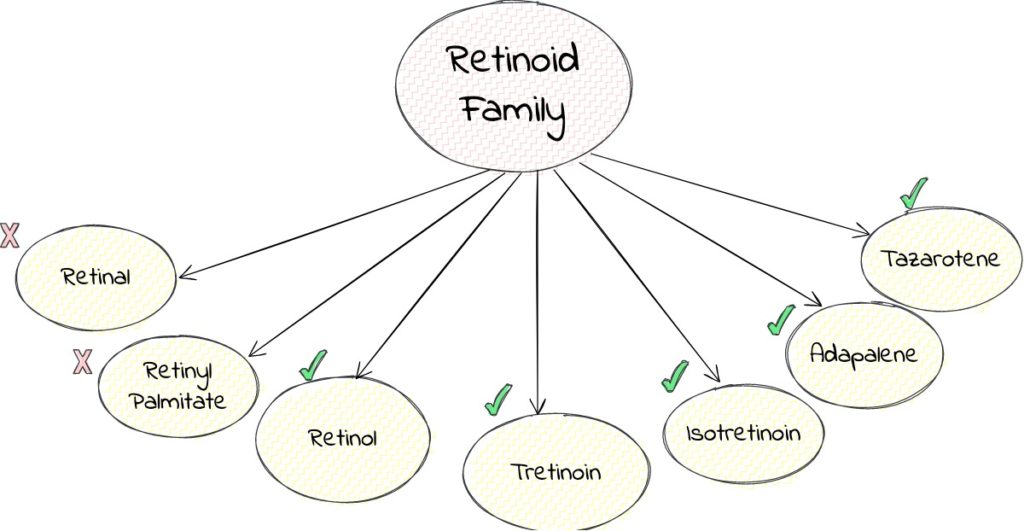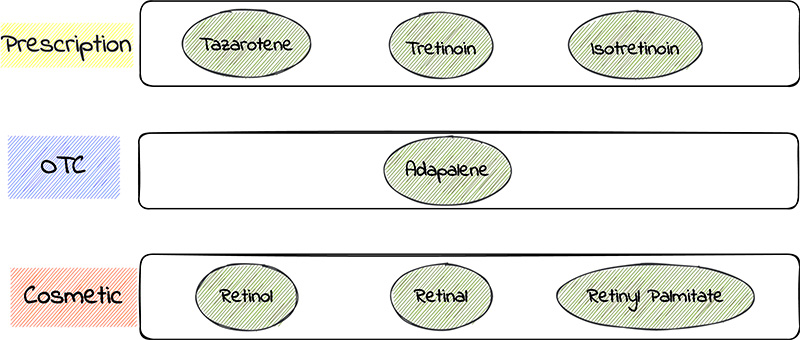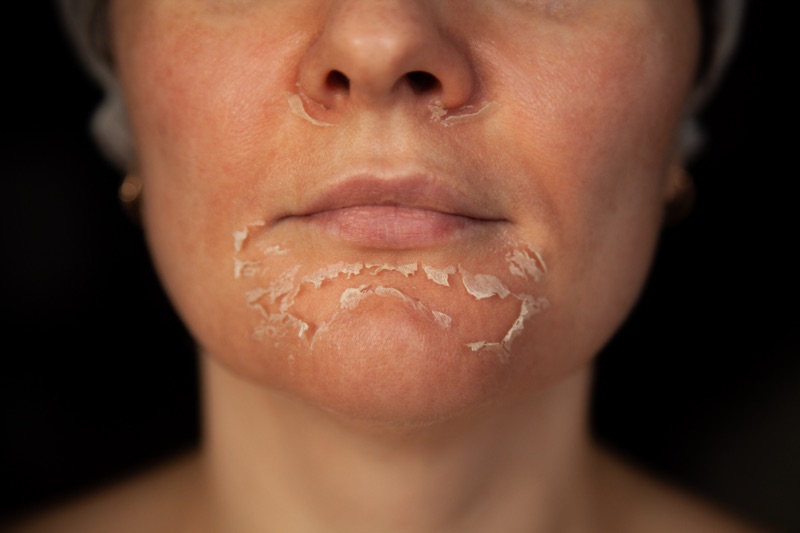The whole Retinoid family is exactly like the Kardashians, difficult & ever confusing to understand. Without wasting much of your time here on the internet, let’s understand the whole family in the easiest way possible.

As the picture tells us
Retinoid is the head of the family & is an umbrella name for all vitamin A ingredients you can find in the market. This whole class of ingredients has been considered skincare royalty. Why? Because they treat everything from acne to hyperpigmentation to increasing collagen production to treating premature wrinkles.
Meet these Retinoids individually
1. Retinol
- The most popular kid of all. Retinol is mild and hence categorized into cosmetic class of retinoids. It is obviously superb for wrinkles, and pigmentation, increasing collagen production by going into the deep layers of the skin, eliminating dead dark cells & generating fresh ones for younger skin.
- Recommended Percentage – 0.25-1%.
- If you’re a beginner, start with 0.25%, 3 times a week & gradually increase to 1%, every other night.
2. Retinyl Palmitate
- This stuff is pointless according to the research & me. It is the weakest retinoid of all. Its skin penetration ability is also questionable so no retinoid fighting power, therefore a waste.
- Still Recommended Percentage – 1%
3. Retinal/Retinaldehyde
- Not the top effective retinoids because of their serious stability issues hence not even easy to find it in products.
- They just have slightly more efficacy than Retinol.
- Recommended Percentage – 0.1-1%
4. Tretinoin /Retinoic acid/Retin-A
- This is the gold standard topical Retinoid, a total bomb ingredient with the longest history of skin benefits.
- This Retinoic acid is used to treat severe acne, mature skin types & all sorts of lines and wrinkles on the face. It is said to be 20 times more effective & potent than retinol, therefore you only get it by prescription from a board-certified dermatologist.
- Recommended Percentage – 0.01-0.1%
5. Adapalene
- It has solid data about treating acne. The exciting part is this amazing ingredient recently became available as an over-the-counter ingredient making life easy.
- This synthetic retinoid has been shown to be gentler than tretinoin. It also helps in clearing acne marks.
- FYI: Don’t exceed the quantity of more than a pea size.
- Recommended Percentage – 0.1%
6. Tazarotene
- Again, a beautiful derivative of Retinoid. It boosts collagen production at a rapid speed & is very effective in treating hyperpigmentation, acne, post-acne scars, and white and blackheads.
- It is also used to treat a skin disease called Psoriasis by slowing skin cell overgrowth & decreasing skin cell inflammation.
- Recommended Percentage – 0.1%
7. Isotretinoin
- It’s called Oral Retinoid. It’s also known by the name Accutane. It’s given for severe cystic acne.
- How does it work? – it basically dries up acne by decreasing the size of sebaceous glands in the skin.
- Sebaceous glands produce sebum & oil which ultimately turn into Pimples by clogging pores.
How do you keep track of them all? I’ll break all these Retinoids simply into 3 classes: Prescription, Over-the-counter & Cosmetic

Now let’s talk about what you have come here for Retinal vs Retinol
| Retinol | Retinal/Retinaldehyde |
| Falls into the class of Cosmetics and hence can be easily found in the market | Falls into the class of Cosmetics and hence can be easily found in the market |
| Recommended % = .25-1% | 0.1%-1.0% |
| Less efficacy than Retinal but much more stable than retinal | It has more efficacy than Retinol but has serious stability issues |
| Can’t be used in pregnancy or nursing | Can’t be used in pregnancy or nursing |
| Builds collagen and treats mild to medium acne. | Used to treat major wrinkles |
| Can be used only at nighttime | Can be used only at nighttime |
Conclusion- Even though Retinal is more potent than Retinol, the stability issues cut all the marks so, go with Retinol, it’s an amazing ingredient to be found readily at the cosmetic level
But hold on, don’t read the half article thinking you can start using Retinol from tomorrow. Retinol has VERY specific rules to apply otherwise it can backfire on the skin with burns, peeled skin, dryness, redness or irritation.
I am writing all the rules for you, go through them & save your skin unnecessary troubles
Retinol Rules to follow for a safe skincare routine!! (Applied for all the Retinoids)
- Always wear sunscreen when you’re out during the day. Using retinol makes your skin highly photosensitive which means the skin is very sensitive to UV light.
- Use Retinol only at night.
- Do not use it very close to your eyes, mouth, or nose.
- Never exceed the quantity of more than a pea size.
- Never forget to use it on the neck as well.
- Don’t apply it on damp skin. Pat, the skin dry first.
- Don’t forget to layer it with a non-comedogenic moisturizer.
- Try & avoid any other potential irritants like acids or chemical exfoliants when you’re beginning your retinol journey. This can minimize your chances of excess flaking or over-exfoliation.

How does Retinol work on the skin?
- It goes deep into the layers of the skin & exfoliates from within by eliminating dead cells & bacterial growth which ultimately leads to the regeneration of fresh young cells & clean pores which helps ultimately in acne control.
Who should not use Retinol?
- If you’re trying for pregnancy, are pregnant or breast feeding, DO NOT use any of the Retinoids.
- People with Rosacea and Eczema shouldn’t use any Retinoids.
What other ingredients is Retinol compatible with?
Retinol doesn’t gel up with most of the ingredients except Niacinamide, Hyaluronic acid & Azelaic Acid
When & how much Retinol to use?
For sensitive skin types & beginners, always start with a low concentration, like .25% & gradually increase to 1%. Start using it twice a week & slowly increase it to every other night.
What if you get any of the Retinol backfires? It can happen & it does happen to people every day in the world. Don’t panic & heal the skin with these tips
Retinol Burns Healing tips

- Avoid using cleansers or moisturizers with fragrances.
- No makeup for a while.
- Use Thermal spring water to calm the skin (Try from La Roche Posay)
- Cold showers will give you a significant improvement.
- Don’t use any exfoliating fancy gadgets to wash your face, simply hands.
- Give a lot of moisture & hydration to the skin for it to feel better. Like moisturizers loaded with ceramides (Helps in skin barrier) & Hyaluronic acid.
- Now, seal the skin with a light layer of Vaseline. It locks in all the goodies we’ve given & heals the skin faster.
- Stop using any other exfoliants, acids, AHAs, BHAs, peroxides, and salicylic acid until you are completely healed.
- Glycerin & Aloe vera, both are great soothing & calming agents for the skin
- Product suggestion- Try ‘Avene- Cicalfate + restorative protective cream’ or mix few drops of hyaluronic acid from ‘the ordinary’ with ‘La Roche Posay’ moisturizer. Seal it with a ‘Cereve healing solution’.
- DO NOT forget to apply sun block before stepping outside. Your skin is already in a vulnerable state. UV rays can make it worse.

Does the Packaging of the Retinol matter?
OH YES! Retinoid packaging is literally everything, which surprisingly very few people know of. Air Exposure means retinol death. So read on.
There are 4 types of packaging in the market.
- Tubes (Best)
- Pump bottles (Better)
- Serum bottles (Okay)
- Jars (NAH)
Tubes are undoubtedly the best & the safest form to use Retinol & beware of the Jars with those big lids. They literally don’t make sense.

Does the storage condition of Retinol matter?
Very much, Retinol is not a stable ingredient in nature & perhaps it likes staying in cool, dark places. Quite away from Sunlight, to maintain its shelf life. Hence, your bathroom cabinets work just fine.
One extra tip, people with Ivory skin should start with the Retinol journey by mid 20s as they tend to develop aging signs sooner compared to dark skin tones.
Have a lovely skin, Love~ Beauty Stroll